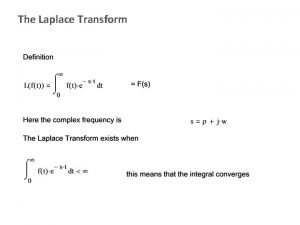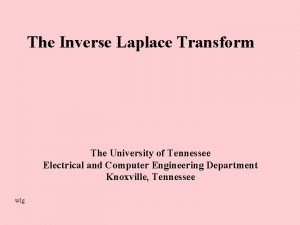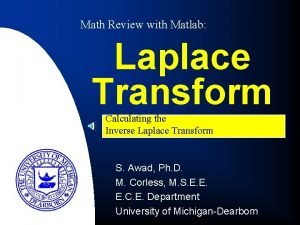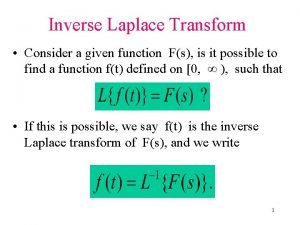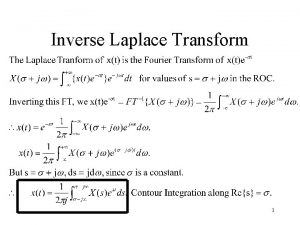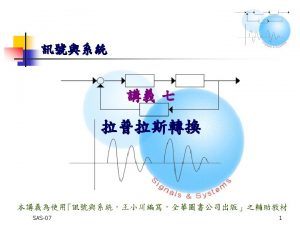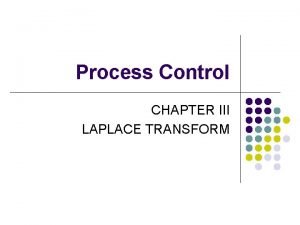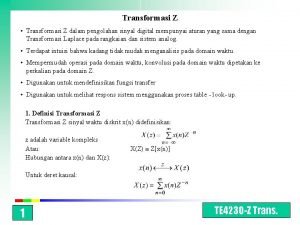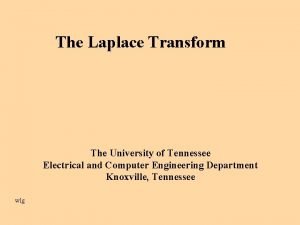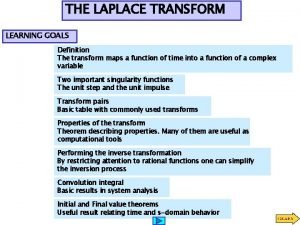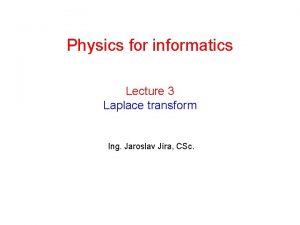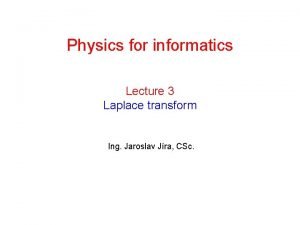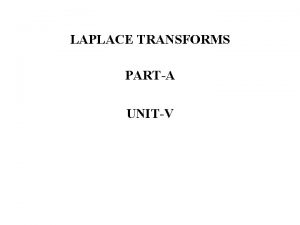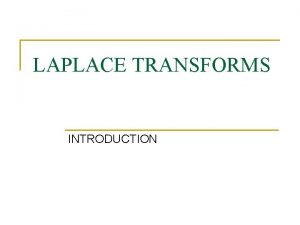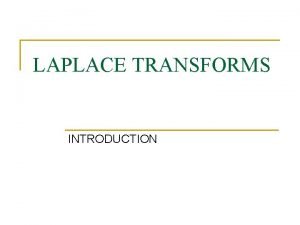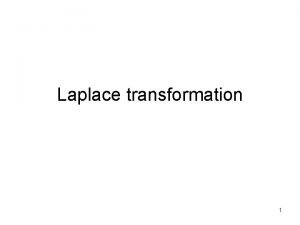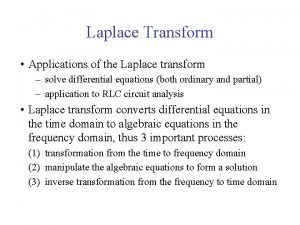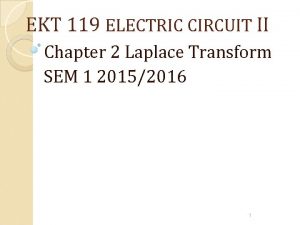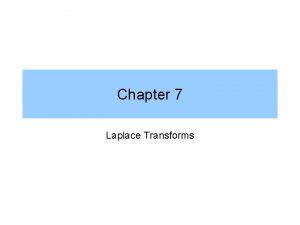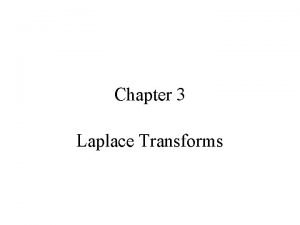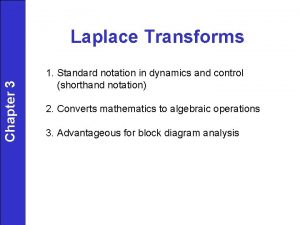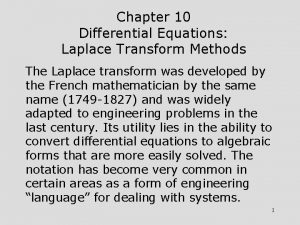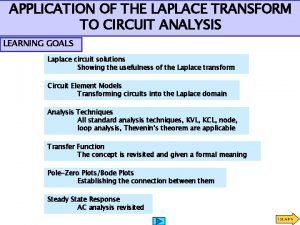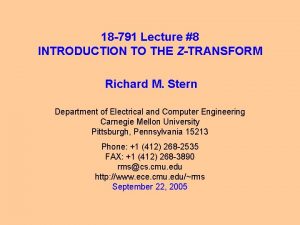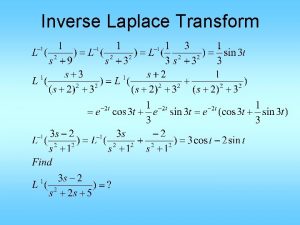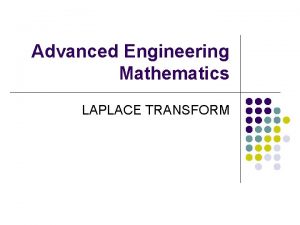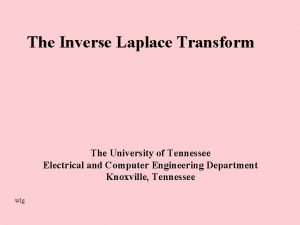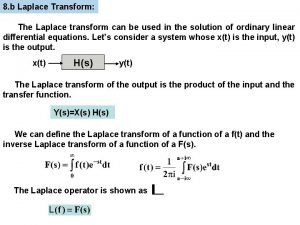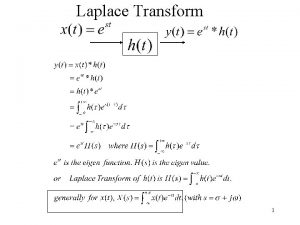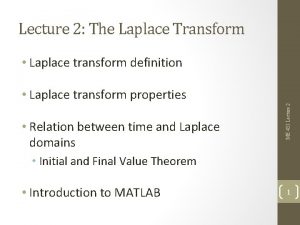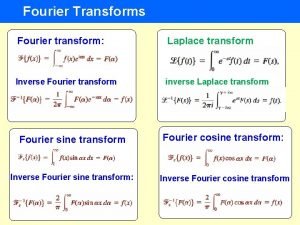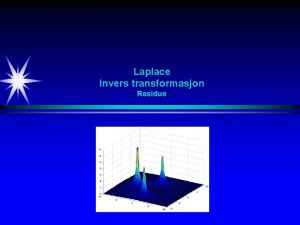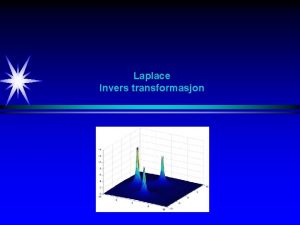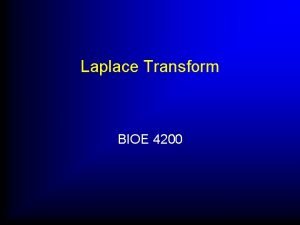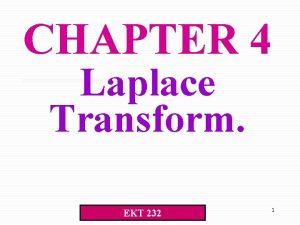The Inverse Laplace Transform The University of Tennessee
























- Slides: 24

The Inverse Laplace Transform The University of Tennessee Electrical and Computer Engineering Department Knoxville, Tennessee wlg

Inverse Laplace Transforms Background: To find the inverse Laplace transform we use transform pairs along with partial fraction expansion: F(s) can be written as; Where P(s) & Q(s) are polynomials in the Laplace variable, s. We assume the order of Q(s) P(s), in order to be in proper form. If F(s) is not in proper form we use long division and divide Q(s) into P(s) until we get a remaining ratio of polynomials that are in proper form.

Inverse Laplace Transforms Background: There are three cases to consider in doing the partial fraction expansion of F(s). Case 1: F(s) has all non repeated simple roots. Case 2: F(s) has complex poles: (expanded) Case 3: F(s) has repeated poles. (expanded)

Inverse Laplace Transforms Case 1: Illustration: Given: Find A 1, A 2, A 3 from Heavyside

Inverse Laplace Transforms Case 3: Repeated roots. When we have repeated roots we find the coefficients of the terms as follows:

Inverse Laplace Transforms Case 3: Repeated roots. Example ? ? ?

Inverse Laplace Transforms Case 2: Complex Roots: K 1 is given by, F(s) is of the form;

Inverse Laplace Transforms Case 2: Complex Roots:

Inverse Laplace Transforms Case 2: Complex Roots: Therefore: You should put this in your memory:

Inverse Laplace Transforms Complex Roots: An Example. For the given F(s) find f(t)

Inverse Laplace Transforms Complex Roots: An Example. (continued) We then have; Recalling the form of the inverse for complex roots;

Inverse Laplace Transforms Convolution Integral: Consider that we have the following situation. x(t) System h(t) y(t) x(t) is the input to the system. h(t) is the impulse response of the system. y(t) is the output of the system. We will look at how the above is related in the time domain and in the Laplace transform.

Inverse Laplace Transforms Convolution Integral: In the time domain we can write the following: In this case x(t) and h(t) are said to be convolved and the integral on the right is called the convolution integral. It can be shown that, This is very important * note

Inverse Laplace Transforms Convolution Integral: Through an example let us see how the convolution integral and the Laplace transform are related. We now think of the following situation: h(t) x(t) y(t) X(s) H(s) Y(s)

Inverse Laplace Transforms Convolution Integral: From the previous diagram we note the following: h(t) is called the system impulse response for the following reason. Eq A If the input x(t) is a unit impulse, (t), the L(x(t)) = X(s) = 1. Since x(t) is an impulse, we say that y(t) is the impulse response. From Eq A, if X(s) = 1, then Y(s) = H(s). Since,

Inverse Laplace Transforms Convolution Integral: A really important thing here is that anytime you are given a system diagram as follows, X(s) Y(s) H(s) the inverse Laplace transform of H(s) is the system’s impulse response. This is important !!

Inverse Laplace Transforms Convolution Integral: Example using the convolution integral. x(t) y(t) = ? e-4 t

Inverse Laplace Transforms Convolution Integral: Same example but using Laplace. x(t) = u(t) h(t) = e-4 tu(t)

Inverse Laplace Transforms Convolution Integral: Practice problems: Answers given on note page

Inverse Laplace Transforms Circuit theory problem: You are given the circuit shown below. Use Laplace transforms to find v(t) for t > 0.

Inverse Laplace Transforms Circuit theory problem: We see from the circuit,

Inverse Laplace Transforms Circuit theory problem: Take the Laplace transform of this equations including the initial conditions on vc(t)

Inverse Laplace Transforms Circuit theory problem:

Stop
 La place table
La place table Inverse laplace transform complex roots
Inverse laplace transform complex roots Inverse laplace transform matlab
Inverse laplace transform matlab Inverse laplace transform integral formula
Inverse laplace transform integral formula Inverse laplace formulae
Inverse laplace formulae Inverse laplace transform
Inverse laplace transform Laplace of derivative
Laplace of derivative Invers transformasi z
Invers transformasi z Laplace transform pairs
Laplace transform pairs Laplace transform of 1
Laplace transform of 1 Scott surgent asu
Scott surgent asu Differential laplace transform
Differential laplace transform Laplace transform of differential equation
Laplace transform of differential equation Laplace transform of impulse
Laplace transform of impulse Final value theorem
Final value theorem Initial and final value theorem
Initial and final value theorem Laplace of constant
Laplace of constant Laplace transformation formulas
Laplace transformation formulas Laplace transform symbol
Laplace transform symbol Use of laplace transform
Use of laplace transform Initial value theorem
Initial value theorem Laplace table
Laplace table Differential laplace transform
Differential laplace transform Laplace transform circuit
Laplace transform circuit Z transform vs laplace
Z transform vs laplace
